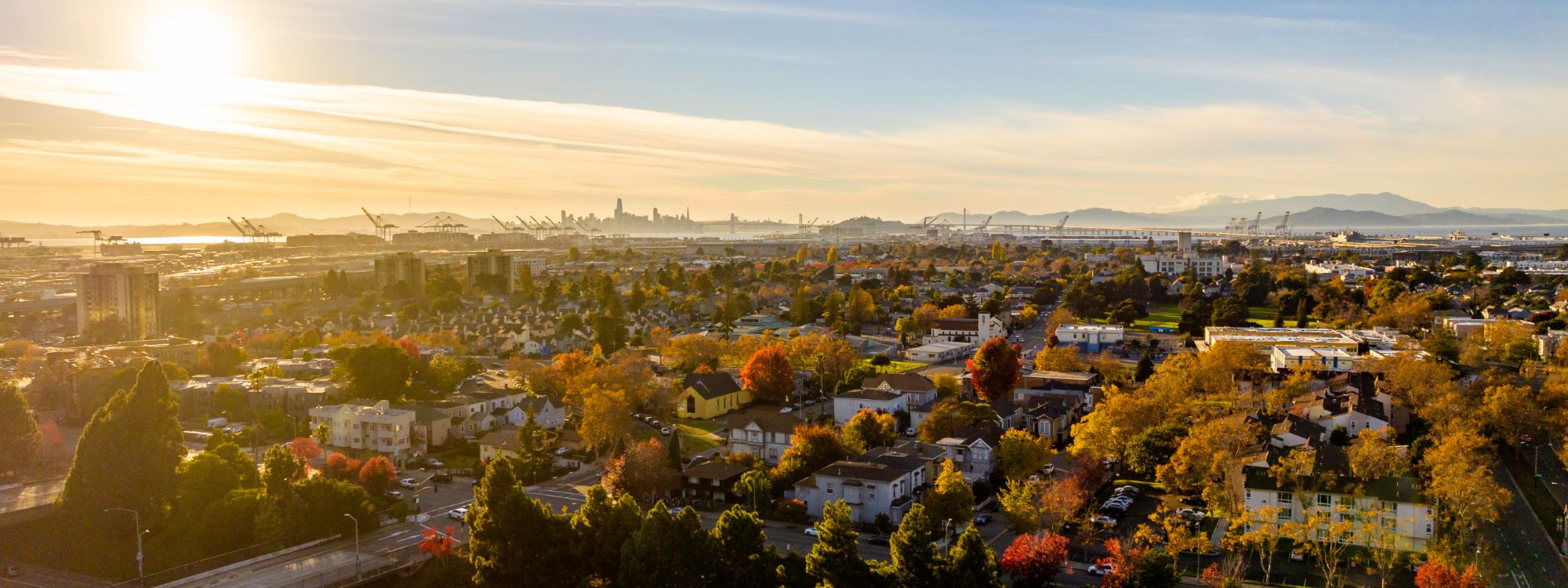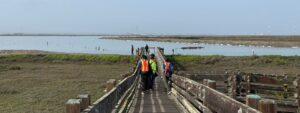As climate change accelerates, Oakland is experiencing an increasing number of extreme heat events. These intense heat events are not only uncomfortable but they pose serious health risks, such as heat stroke and aggravation of pre-existing conditions. Often overlooked, the built environment — aspects of our urban surroundings that are constructed by people — exacerbates extreme heat impacts. Understanding how the design, infrastructure, and construction of our cities impact extreme heat and heat-related illness is crucial for developing effective climate mitigation strategies.
In recent years, Oakland has faced more frequent and intense heat waves. According to the Environmental Protection Agency, the average number of heat waves has increased from two per year in the 1960s to six per year in the 2010s and 2020s. Oakland is expected to have seven “hot days” this year, meaning days with temperatures 84℉ or above, and the number of hot days in Oakland is projected to increase to 15 a year in 30 years. This increase in the frequency of heat puts additional stress on residents and infrastructure.
The Built Environment’s Role in Extreme Heat
The built environment encompasses all human-made structure and spaces, including buildings, roads, and public areas. Several key aspects of the built environment contribute to the intensity of how people experience heat waves and the health risks associated with them:
- Urban Heat Island Effect: Urban areas, including Oakland, often experience higher temperatures than surrounding rural areas. This phenomenon, known as the Urban Heat Island Effect (UHI), occurs due to the abundance of heat-absorbing materials like asphalt and concrete, along with the lack of vegetation. These materials absorb and retain heat, creating a localized “heat island” that heightens the impact of heat waves.
- Lack of Tree Coverage: Trees provide a crucial role in the cooling of urban areas. They provide shade, release moisture through transpiration, and reflect sunlight. In Oakland, there is an uneven distribution of trees. There is only 9% tree coverage in the flatlands while there is 43% tree coverage in the Oakland hills where more affluent communities live. The lack of trees in the flatlands results in higher surface and air temperatures for Oakland’s frontline communities.
- Building and Design Insulation: The design and materials used in building construction significantly impact indoor temperatures. Poorly insulated buildings can trap heat, making them unbearably hot during heat waves. High energy consumption for air conditioning can also lead to power outages and increased greenhouse gas emissions.
- Infrastructure and Heat Absorption: Road and pavement, particularly those made of dark-colored materials, absorb and retain heat. This “thermal mass” effect contributes to higher ambient temperatures and intensifies overall heat load in urban areas.
Health Impacts of Extreme Heat
Extreme heat can have dire consequences on public health. Some health impacts of extreme heat include:
- Heat-Related Illness: Prolonged exposure to high temperatures can lead to heat exhaustion, heat stroke, and dehydration. Vulnerable populations such as the elderly, children, and those with chronic health conditions are at greater risk.
- Respiratory Illness: High temperatures can exacerbate respiratory conditions like asthma, as heat can increase the concentration of ground-level ozone and other pollutants.
Cardiovascular Strain: Extreme heat places additional strain on the cardiovascular system, potentially leaving heart attacks or complications in individuals with pre-existing heart conditions. - Economic and Social Strain: Heat waves often disrupt daily life, leading to economic losses due to reduced productivity and increased healthcare costs. Vulnerable communities may face greater challenges due to limited access to cooling resources and healthcare.
Strategies for Mitigating Heat Risks
Addressing the impact of the built environment on extreme heat requires a multi-faceted approach.
- Increasing Green Spaces: Expanding and enhancing urban green spaces, such as parks, community gardens, and green roofs, can help reduce the UHI effect and provide critical cooling relief.
- Implementing Cool Roofs and Pavements: Utilizing reflective or “cool” materials for roofs and pavements can decrease the amount of heat absorbed and help lower surface temperatures.
- Improved Building Design: Investing in better insulation, energy-efficient cooling systems, and passive cooling designs can reduce indoor temperatures and improve comfort during heat waves.
- Community Planning and Education: Urban planners and policymakers need to prioritize heat mitigation strategies in new development and renovations. Additionally, educating residents about the risks of extreme heat and providing resources such as cooling centers can help protect public health.
As Oakland continues to experience the effects of climate change, understanding the role of the built environment in amplifying extreme heat is crucial. By addressing factors such as urban heat islands, green space distribution, and building design, the city can better mitigate the health impacts of heat waves. Collaborative efforts among residents, policymakers, and urban planners are essential in creating a more resilient and livable city.
As we adapt to these new climate realities, focusing on sustainable and collaborative urban development will be key to safeguarding public health and enhancing our quality of life in the face of extreme heat.
AJ Olsen is Greenbelt Alliance’s Summer Resilience Intern through Enterprise for Youth’s Climate Career Corps Individual Placements program.





